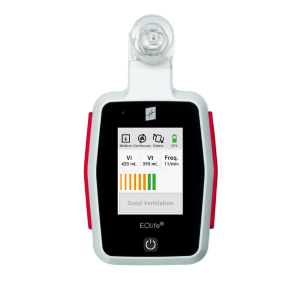Bag-valve-mask (BVM) ventilation is a critical skill in emergency medicine, particularly during cardiac arrest. During such events, effective manual ventilation has been shown to significantly impact both survival rates and neurological outcomes. To stop mask leaks and improve ventilation during CPR is essential.
Despite its importance, manual ventilation remains a challenging technique that is often poorly performed by healthcare providers. A recent study conducted by the Paris Fire Brigade demonstrated that even professional firefighters struggled to maintain an adequate mask seal during ventilation. This resulted in high leakage and low tidal volumes. These outcomes fell well below the recommendations in current resuscitation guidelines.
Below are key recommendations to stop mask leaks, improve mask seal and deliver effective BVM ventilation.
1️⃣ Choose the right mask size
Not all healthcare providers are aware that mask size must be adapted to the patient’s facial anatomy to avoid leaks. Most mask models are available in multiple sizes. The appropriate mask should cover both the nose and mouth entirely, including the corners of the lips.
The top of the mask should be positioned at the base of the nasal bridge — not too low on the nasal cartilage and not too high on the forehead. The bottom of the mask should sit comfortably under the chin. Also note that not all masks are equal. Some are designed with superior anatomical fit and flexibility, which can significantly reduce leakage.
2️⃣ Head position matters
Proper head positioning is crucial for maintaining airway patency and achieving a good mask seal. The standard technique is the head-tilt, chin-lift, which opens the upper airway by extending the head and lifting the chin. When trauma is not suspected, this is the recommended maneuver. If additional airway opening is needed, the jaw-thrust technique can be used. This technique advances the mandible forward without moving the cervical spine.
It’s essential to maintain this head position throughout the duration of ventilation. It ensures consistent airflow and minimizes the risk of obstruction.
3️⃣ Master your hand technique
Hand placement plays a critical role in minimizing leaks and ensuring adequate ventilation. Poor hand positioning—such as pressing on the soft parts of the mask—can compromise the seal.
👤 One-person technique
The most common method for a single rescuer is the “E-C” or “E-O” seal:
- The thumb and index finger form a “C” or “O” around the center of the mask to hold it against the face.
- The other three fingers form an “E” along the bony part of the jaw to lift it upward and maintain airway alignment.
Ensure there are no gaps between the mask and the patient’s face.
👥 Two-person technique
With two rescuers, one person holds the mask using both hands in the E-C technique while the other squeezes the bag. This approach has been shown in simulation studies to provide better mask seal, higher tidal volumes, and more consistent ventilation.
4️⃣ Avoid over-squeezing the bag
One of the most common mistakes in manual ventilation is over-squeezing the bag. This can generate excessively high inspiratory pressures, which are detrimental to maintaining a proper mask seal. High pressures tend to increase the likelihood of air leaks around the mask, especially if the seal is already suboptimal. Because these leaks reduce the effective tidal volume delivered to the patient, they may go unnoticed, compromising ventilation quality during critical situations.
To avoid this, providers should aim to squeeze the bag gently—just enough to deliver the adequate tidal volume.
5️⃣ Use a Ventilation Feedback Device (VFD)
Even when following all the best practices outlined above—selecting the right mask size, optimizing head position, using proper hand techniques, and avoiding high pressures—it remains extremely difficult to detect and manage leaks without real-time data. Leaks can be subtle and easily overlooked, leading to dangerously ineffective ventilation.
That’s why it is essential to measure ventilation quality and assess for leakage continuously. Ventilation Feedback Devices (VFDs) provide real-time information on the actual volumes delivered to the patient. Thus, making it possible to detect issues like leaks or over-ventilation as they happen. This feedback empowers providers to make immediate corrections and deliver more effective, guideline-compliant ventilation.
EOlife, the only Ventilation Feedback Device (VFD) to display the volume of gas reaching the patient’s lungs (Tidal Volume).
CE-marked and FDA-cleared medical device enabling real-time measurement of insufflated volume, tidal volume, and ventilation frequency. It provides visual feedback to deliver ventilation following ERC or AHA recommendations.
Perfect you Tidal Volume delivery and improve survival with EOlife
Find out more



